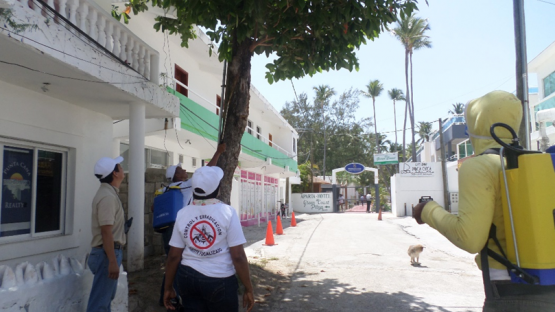In late 2014, an outbreak of Mediterranean fruit fly (medfly) was detected in Punta Cana, a major tourist area in eastern Dominican Republic. Until that time, Hispaniola and all other islands of the Caribbean were free of the medfly, one of the worst horticultural pests, which attacks over 250 types of fruits and vegetables. As a result of the outbreak, medfly-free countries importing avocados, mangoes, peppers, tomatoes and other Dominican horticultural products closed their markets partially or completely, causing hardship and major economic loss to producers and exporters.
In March 2015, the Ministry of Agriculture of the Dominican Republic launched an emergency response programme and requested the help of the IAEA. The Moscamed Program in Guatemala/Mexico, United States Department of Agriculture (USDA), along with the Food and Agriculture Organization of the United Nations (FAO), International Atomic Energy Agency (IAEA), Interamerican Institute for Cooperation in Agriculture of the Organization of American States (IICA), and the regional plant protection organisation (OIRSA) are providing coordinated technical and financial assistance to the emergency response efforts of the Dominican Republic. Based on these efforts, the expanding pest outbreak has been contained, however, a major eradication campaign is still required to eliminate the medfly from the Dominican Republic. An extensive trapping network has been deployed in strategic sites within the infested area and throughout the country in order to clearly assess the spatial distribution of the pest. Furthermore, to enhance the suppression efforts in the outbreak area, and with the ultimate goal of eliminating the remaining fruit fly populations and preventing the establishment of new populations, bait sprays and the destruction of infested fruit is being integrated with the IAEA-supported application of the sterile insect technique (SIT). The sterile males, when released on an area-wide basis, assure the elimination of remnant populations in view that they are very effective in finding and mating with the last wild females present so that they have no offspring.
With increasing globalization, increasing importance must be placed on preventing the incursion and spread of pests and diseases that affect agricultural production. Therefore strengthening the quarantine systems and the phytosanitary treatment of products brought on to Hispaniola is important to prevent similar outbreaks. Furthermore, regional harmonization and strengthening of fruit fly management at the pre- and post-harvest level, following international standards of phytosanitary measures is essential. In conjunction with OIRSA and other regional partners, a technical cooperation (TC) project is planned for 2016 in the Latin America and the Caribbean region in order to strengthen Fruit Fly surveillance and control measures by using the Sterile Insect Technique.
This regional project aims to strengthen and harmonize fruit fly surveillance and management capacities at the pre-harvest level, in combination with post-harvest phytosanitary treatment of agricultural commodities to enable the export of fresh fruits and vegetables from countries in the region.



